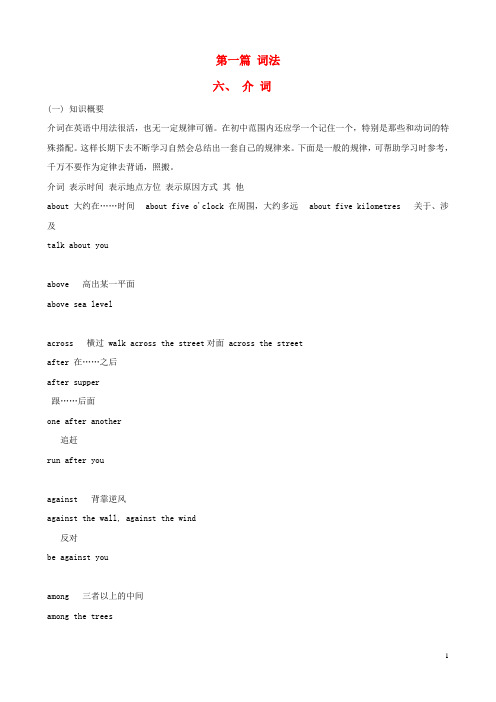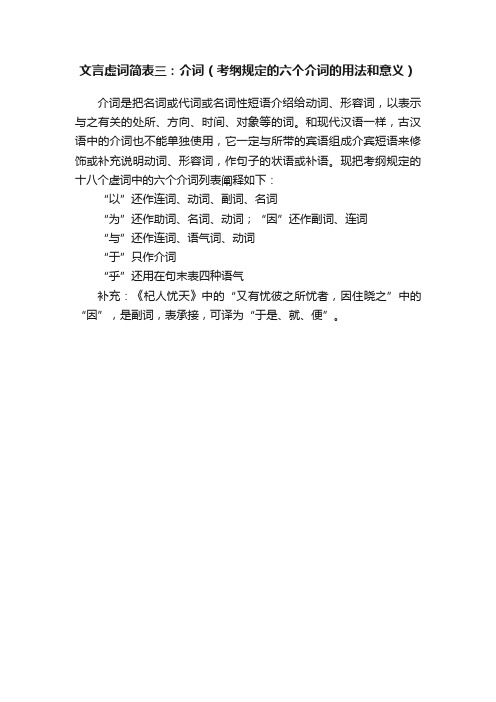第一篇六介词
- 格式:doc
- 大小:93.50 KB
- 文档页数:12

,介词的分类1. 简单介词,是指单个的介词女口:in, on, at, on, to, with 等2. 合成介词,是指两个简单介词合在一起构成的介词如:in to, on to, without, i nside3. 短语介词,是指一个或两个简单介词与一个或几个其他词类的词组合,在意义和作用上相当于一个简单介词的短语如:in stead of 代替because of 因为accord ing to 按照二,表示时间的介词in front of在…的前面1. at表示具体的时间点女口:at eight o'clock联想:at构成的固定短语:at first 首先at least 至少at prese nt 目前at noon在中午at the age of在…岁时at the same time同时at the end of在。
末at the mome nt在目前,现在at school在上学女口: _________________________________________________ In some wester n coun tries shops are closed _____________________________ w eeke nds.2. in用于年,月,季节,上午,下午,晚上等。
in March在三月in spri ng在春天in 2008 在2008 年in the morni ng/afterno on /eve ning注意:in表示在某一季节或某一月份时,一般不加冠词,但季节和月份的意义一旦具体化,就要加定冠词the。
女口:The weather is a little in May.An earthquake happe ned in Sichua n in the May of 2008.In summer childre n are happy because they can swim.联想:in构成的固定短语:show great interest in 对。

初中常见介词全文共四篇示例,供读者参考第一篇示例:介词是一种常见的语法成分,用来连接名词、代词、动词等成分之间的关系,起到修饰、限定或状语的作用。
在英语当中,介词是一种很重要的词类,也是语法学习中的重要内容之一。
今天我们就来讲述一下关于中学生常见的介词,希望能够帮助大家更好地理解和掌握介词的用法。
在英语当中,介词通常是一个短小的词,但是它有着非常重要的作用。
介词可以表示时间、地点、方向、目的、原因等各种关系。
下面我们来看看一些中学生常见的介词及其用法。
1. in"in"是一个常见的介词,表示在某个时间、地点或范围内。
比如:- We have English class in the morning.(我们早上上英语课。
)- There are many books in the library.(图书馆里有很多书。
)- I am interested in music.(我对音乐感兴趣。
)10. without"without"是一个表示没有、缺少某物或某种情况的介词。
比如:- She goes to school without her bag.(她没带书包去学校。
)- He can't eat spicy food without water.(他吃不了辣的东西不喝水。
)- You can't pass the test without studying.(不学习就通不过考试。
)通过以上介绍,我们可以看到,介词在英语中起着非常重要的作用。
掌握常见的介词并且熟练运用它们,可以帮助我们更好地理解和使用英语,提高我们的语言表达能力。
希望大家能够通过学习介词,提高自己的英语水平,表达更加准确、灵活和流畅。
祝大家学习进步,使用愉快!第二篇示例:介词是一类用于连接名词、代词、动词或其他词组的词语,在句子中起到限定或修饰的作用。
在英语中,介词是非常重要的一部分,不仅能够帮助我们表达句子的关系,还可以让语言更加丰富和生动。

第一篇词法六、介词(一) 知识概要介词在英语中用法很活,也无一定规律可循。
在初中范围内还应学一个记住一个,特别是那些和动词的特殊搭配。
这样长期下去不断学习自然会总结出一套自己的规律来。
下面是一般的规律,可帮助学习时参考,千万不要作为定律去背诵,照搬。
介词表示时间表示地点方位表示原因方式其他about 大约在……时间 about five o'clock 在周围,大约多远 about five kilometres 关于、涉及talk about youabove 高出某一平面above sea levelacross 横过 walk across the street对面 across the streetafter 在……之后after supper跟……后面one after another追赶run after youagainst 背靠逆风against the wall, against the wind反对be against youamong 三者以上的中间among the treesat 在某时刻at ten在小地点at the school gate表示速度at high speed向着,对着at mebefore 在……之前before lunch位于……之前sit before mebehind 位于……之后behind the treebelow 低于……水平below zero不合格below the standardby 到……时刻,在……时刻之前by five o'clock紧挨着site by site乘坐交通工具 by air, by bick 被由was made by usduring 在……期间during the holidays for 延续多长时间for five years向……去leave for Shanghai 为了,对于be good for youfrom 从某时到……某时 from morning till night 来自何方 from New York由某原料制成be made from来自何处where are you fromin 在年、月、周较长时间内 in a week 在里面in the room用某种语言 in English 穿着in redinto 进入……里面walk into除分divide into变动turn into waternear 接近某时 near five years 在……附近 near the park of 用某种原料制成be made of属于……性质a map of U. S .Aon 某日、某日的上下午on Sunday afternoon 在……上面on the desk 靠吃……为生live on rice 关于 a book on Physicsover 渡过一整段时间 work over night 在上方over the desk超过,高于 over five pairspast 超过某一时刻ten past five经过某地walk past the parksince 从某时以来since 1980原因Since you were illthrough 经过某一时期 through his life 通过、穿过某地 through the foresttill until 直到某时为止 till five o'clockto 差多少时间five to ten问,到,去往to Shanghai面对面face to face给予give a book to meunder 在……下面under the desk少于under ten在……管制之下 under the rulewith 用某种工具 with a pen 带着,具有with mewithout 没有without air(二) 正误辨析[误] We got to the top of the mountain in daybreak.[正] We got to the top of the mountain at day break.[析] at用于具体时刻之前,如:sunrise, midday, noon, sunset, midnight, night。

文言虚词简表三:介词(考纲规定的六个介词的用法和意义)
介词是把名词或代词或名词性短语介绍给动词、形容词,以表示与之有关的处所、方向、时间、对象等的词。
和现代汉语一样,古汉语中的介词也不能单独使用,它一定与所带的宾语组成介宾短语来修饰或补充说明动词、形容词,作句子的状语或补语。
现把考纲规定的十八个虚词中的六个介词列表阐释如下:
“以”还作连词、动词、副词、名词
“为”还作助词、名词、动词;“因”还作副词、连词
“与”还作连词、语气词、动词
“于”只作介词
“乎”还用在句末表四种语气
补充:《杞人忧天》中的“又有忧彼之所忧者,因住晓之”中的“因”,是副词,表承接,可译为“于是、就、便”。

介词的用法1.表示地点位置的介词1)at ,in, on, to,forat (1)表示在小地方; (2)表示“在……附近,旁边”in (1)表示在大地方; (2)表示“在…范围之内”。
on 表示毗邻,接壤,“在……上面”。
to 表示在……范围外,不强调是否接壤;或“到……”2)above, over, on 在……上above 指在……上方,不强调是否垂直,及 below相对;over指垂直的上方,及under相对,但over及物体有一定的空间,不直接接触。
on表示某物体上面并及之接触。
The bird is flying above my head. There is a bridge over the river. He put his watch on the desk.3)below, under 在……下面under表示在…正下方below表示在……下,不一定在正下方There is a cat under the table.Please write your name below the line.4)in front [frant]of, in the front of在……前面in front of…意思是“在……前面”,指甲物在乙物之前,两者互不包括;其反义词是behind(在……的后面)。
There are some flowers in front of the house.(房子前面有些花卉。
) in the front of 意思是“在…..的前部”,即甲物在乙物的内部.反义词是at the back of…(在……范围内的后部)。
There is a blackboard in the front of our classroom.我们的教室前边有一块黑板。
Our teacher stands in the front of the classroom.我们的老师站在教室前.(老师在教室里)5)beside,behindbeside 表示在……旁边behind 表示在……后面2.表示时间的介词1)in , on,at 在……时in表示较长时间,如世纪、朝代、时代、年、季节、月及一般(非特指)的早、中、晚等。

介词讲义介词是一种虚词,用来表示名词或相当于名词的其它词语句中其它词的关系,不能单独使用。
介词可与名词或相当于名词的其它词构成介词短语。
当介词后直接跟动词时,动词用—ing形式。
II表示时间的介词(1) at,on,in1)at:用于表示时刻、时间的某一点at noon正午时at night在夜间at present目前at nine在九点钟2)on:用于某天,某一天的上、下午(指具体的某一天时,一律用on)注意:泛指一般的上午(下午)时用in,但特指某日的上午(下午)时用on。
in the morning在早上on sunday morning在周日早上on Monday在周一on Tuesday morning在周二早上on May 4,1996在1996年5月4日on a cold night在一个寒冷的夜晚on the night of July(the) first在七月一日的夜晚3)in:用于表示一段时间,用于年、月、世纪、四季或泛指的一天的上午、下午或晚上等名词前,还可用于表示“从现在起,多长时间之后”如:in three days.注意:在this,last,next,every等词前面不能再加介词。
this morning今天上午last Friday 上周五next Sunday下周日in the week在这周in May在五月in spring在春季in 1995在1995年in September,1995在1995年9月in the morning在上午in the afternoon在下午in the evening在晚上(2)in,after1) in:过……后(未来时间) in是以现在为基准,in an hour是指从现在起1小时之后,所以一般只用于将来时。
用how soon 或when 提问。
in an hour 一小时之后in a week or so 一个多星期之后He will be back in five hours.他五小时之后回来。
介词用法总结小升初知识点一、介词的基本概念介词是一种虚词,用来连接名词、代词或动名词与其他词语。
介词通常放在名词、代词或动名词之前,用来说明它们与其他词语之间的关系。
介词一般单独使用,但有时也会与其他介词形成短语,如in front of, because of等。
二、介词的分类介词根据其所表示的意义可以分为几种类型,常见的有时间介词、地点介词、方向介词、原因介词等。
1. 时间介词时间介词用来表示时间上的关系,例如at, on, in, before, after, during, for, since等。
它们的用法如下:- at:用于表示具体的某一天、某个具体的时间点,如at 5 o'clock, at Christmas等。
- on:常用于表示某一天或日期,如on Monday, on May 1st等。
- in:用来表示大范围的时间,如in the morning, in summer等。
也可用于表示月份、季节、年份等,如in April, in 2022等。
- before:表示在某一时间之前,如before lunch, before Christmas等。
- after:表示在某一时间之后,如after dinner, after class等。
- during:表示在某一时间段内,如during the meeting, during the holiday等。
- for:表示持续的时间,如for two hours, for a week等。
- since:表示从某一时刻开始,如since last year, since 9 o'clock等。
2. 地点介词地点介词用来表示地点或位置上的关系,例如in, on, at, by, under, over, behind, in front of 等。
它们的用法如下:- in:用来表示在某一范围内的地点,如in the room, in Beijing等。
鲁教版六年级英语上册(初一)介词表简介本文档为鲁教版六年级英语上册(初一)的介词表,提供了该教材中涉及的常用介词及其用法。
介词是英语中非常重要的一部分,它们用于表示时间、地点、方向、原因等方面的关系。
掌握常用介词的用法,有助于提高学生对英语句子的理解和运用能力。
介词表以下是鲁教版六年级英语上册(初一)介词表,包括常用的介词及其用法:- about:关于,大约- above:在…上面- across:横过- after:在…之后- against:反对- among:在…之中- around:在…周围- as:作为- at:在…地方- before:在…之前- behind:在…后面- below:在…下面- beside:在…旁边- between:在…之间- beyond:在…之外- by:通过- down:向下- during:在…期间- for:为了- from:从…出发- in:在…里面- into:进入- near:靠近- of:属于- off:离开- on:在…上面- out:在…之外- over:在…上方- through:穿过- to:到- under:在…下面- up:向上- with:与…一起请根据教材内容结合具体语境进行介词的选用和使用。
需要注意的是,介词的用法在不同语境中可能存在细微差别,请结合具体情况进行理解和掌握。
> 注意: 以上介词表列举了一些常用的介词,还有其他介词也是用于特定的场合,我们建议根据具体需求结合研究材料进行选择。
结束语通过掌握这份《鲁教版六年级英语上册(初一)介词表》,学生能够更好地理解英语中介词的用法,并在日常研究和交流中正确运用。
希望这份介词表能对学生的研究有所帮助。
祝学习进步!。
介词的总结介词的总结第一篇介词的总结第二篇介词的总结第五篇介词的总结第六篇介词的总结第9篇一、表示时间的介词时间介词有in , on,at,after,since,during,by,before,after,until 等,前三个介词用法有个口诀:at午夜、点与分,上午、下午、晚用in。
年、月、年月、季节、周,之前加上介词in。
将来时态多久后,这些情形亦用in。
日子、日期、年月日,星期之前要用on。
其余几组常见的时间介词辨析如下辨析如下:1、时间介词in与after 的用法辨析介词in + 一段时间用于一般将来时。
如:We’ll go to school in two weeks.介词after + 一段时间用于一般过去时。
如:My mother came home after half an hour.介词after + 时间点常用于一般将来时。
如:We’ll go out for a walk after supper.2、时间介词for与since的用法辨析介词for 表示一段时间如:I have been living here for 10 years.介词since 表示从过去某一时间以来如:I have been living heresince 2000.3、时间介词before与by的用法辨析介词before表示“在…之前〞如:He won’t come back before five .介词by表示“到…时为止,不迟于…〞如:The work must be finished by Friday.4、时间介词during与for的用法辨析当所指的时间起止分明时用介词during如:He swims every day during the summer.假如一段时间不明确则用介词for如:I haven’t seen her for years.5、时间介词till与until用法的异同till和until用在确定句中,均可表示“直到…为止〞,如:I will wait till〔until〕seven o'clock.till和until用在否认句中,均可表示“在…以前〞或“直到…才〞。
英语常用介词以及用法全文共四篇示例,供读者参考第一篇示例:英语中的介词是一类常见的词性,它通常用来在句子中引起名词、代词、动词等成分之间的关系。
这些关系主要包括位置、方向、时间、原因、方式等。
介词在英语中扮演着非常重要的角色,掌握常用介词以及它们的用法对于提升写作和口语能力至关重要。
下面将介绍一些常用的英语介词以及它们的用法。
1. In"In" 是一个非常常用的介词,它通常表示某物在某个位置或状态中。
比如:- I am in the kitchen.(我在厨房)- She is in a meeting.(她在开会)- The cat is in the box.(猫在盒子里)"in" 也可以表示时间的概念:- The meeting is in the afternoon.(会议在下午)2. On- We will have a party on Christmas Day.(我们将在圣诞节那天举办派对)3. At"At" 用于表示某物在某个具体的地点或时间。
比如:"At" 还可以表示某种状态或情况:4. By"By" 可以表示近旁、附近,或通过某种方式。
比如:- The park is by the river.(这个公园在河边)- She goes to work by bus.(她乘公交车上班)5. With"With" 表示陪伴、一起,也可以表示使用某种工具或手段。
比如:- He is happy with his new job.(他对他的新工作感到高兴)6. For"For" 通常表示目的、原因、利益。
比如:- I bought a gift for my sister.(我给我妹妹买了份礼物)- He is studying for the exam.(他正在为考试而学习)"From" 表示从某处出发或起源。
六、介词(一) 知识概要介词在英语中用法很活,也无一定规律可循。
在初中范围内还应学一个记住一个,特别是那些和动词的特殊搭配。
这样长期下去不断学习自然会总结出一套自己的规律来。
下面是一般的规律,可帮助学习时参考,千万不要作为定律去背诵,照搬。
介词表示时间表示地点方位表示原因方式其他about 大约在……时间 about five o'clock 在周围,大约多远 about five kilometres 关于、涉及talk about youabove 高出某一平面above sea levelacross 横过walk across the street对面across the streetafter 在……之后after supper跟……后面one after another追赶run after youagainst 背靠逆风against the wall, against the wind反对be against youamong 三者以上的中间among the treesat 在某时刻at ten在小地点at the school gate表示速度at high speed向着,对着at mebefore 在……之前before lunch位于……之前sit before mebehind 位于……之后behind the treebelow 低于……水平below zero不合格below the standardby 到……时刻,在……时刻之前by five o'clock紧挨着site by site乘坐交通工具 by air, by bick 被由was made by usduring 在……期间during the holidaysfor 延续多长时间for five years向……去leave for Shanghai 为了,对于be good for youfrom 从某时到……某时 from morning till night 来自何方 from New Y ork由某原料制成be made from来自何处where are you fromin 在年、月、周较长时间内 in a week 在里面in the room用某种语言 in English 穿着in redinto 进入……里面walk into除分divide into变动turn into waternear 接近某时 near five years 在……附近 near the parkof 用某种原料制成be made of属于……性质a map of U. S .Aon 某日、某日的上下午on Sunday afternoon 在……上面on the desk 靠吃……为生live on rice 关于 a book on Physicsover 渡过一整段时间 work over night 在上方over the desk超过,高于 over five pairspast 超过某一时刻ten past five经过某地walk past the parksince 从某时以来since 1980原因Since you were illthrough 经过某一时期 through his life 通过、穿过某地through the foresttill until 直到某时为止 till five o'clockto 差多少时间five to ten问,到,去往to Shanghai面对面face to face给予give a book to meunder 在……下面under the desk少于under ten在……管制之下under the rulewith 用某种工具 with a pen 带着,具有with mewithout 没有without air(二) 正误辨析[误]We got to the top of the mountain in daybreak.[正]We got to the top of the mountain at day break.[析]at用于具体时刻之前,如:sunrise, midday, noon, sunset, midnight, night。
[误]Don't sleep at daytime[正]Don't sleep in daytime.[析]in 要用于较长的一段时间之内,如:in the morning / afternoon, 或in the week / month / year. 或in spring / supper /autumn / winter等等。
[误]We visited the old man in Sunday afternoon.[正]We visited the old man on Sunday afternoon.[析]in the morning, in the afternoon 如果在这两个短语中加入任何修饰词其前面的介词都要改为on, 如:on a cold morning, on the morning of July 14th[误]He became a writter at his twenties[正]He became a writter in his twenties[析]这句话应译为:他在20多岁时就成了作家。
在某人的一段生活时间段中要用介词in 来表示,而在具体岁数时用at来表示。
[误]He went to New Y ork to find a job in sixteen years old.[正]He went to New Y ork to find a job at sixteen.[析]在具体年岁前用at, 如:at the age of 12,at your age,等等。
[误]We went to swim in the river in a very hot day.[正]We went to swim in the river on a very hot day.[析]具体某一天要用介词on, 又如:on New Y ear's Day[误]I'm looking forward to seeing you on Christmas.[正]I'm looking for ward to seeing you at Christmas.[析]在节日的当天用on,而全部节日期间用at,Christmas是圣诞节期间,一般要有两周或更长的时间。
[误]I haven't see you during the summer holidays.[正]I haven't seen you since the beginning of the summer holidays.[析]during表示在某一段时间之内,所以一般不与完成时搭配,如:I visited a lot of museums during the holiday. 而for表示一段时间,可以用于完成时,如:I haven't see you for a long time. 而through 用来表示时间时则为"整整,全部的时间"。
如:It rained through the night. 而since则是表达主句动作的起始时间,一般要与完成时连用。
[误]At entering the classroom, I heard the good news.[正]On entering the classroom, I heard the good news.[析]On 加动名词表示"一……就"。
本句的译文应是:我一进入教室就听见这个好消息了。
又如:on hearing…一听见,on arrival 一到达就……(on表示动作的名词)[误]In the beginning of the book, there are some interesting stories.[正]At the beginning of the book, there are some interesting stories.[析]at the begining与at the end都是指某事物的开始与结束部分,均不指时间范围,而in the beginning 则是指开始一段时间。
in the end=at last是指"最终,终于"之意。
[误]Till the end of next week. I will have finished this work.[正]By the end of next week. I will have finished this work.[析]by 引起的时间状语表示了动作的截止点,其意思为"不迟于某一时刻将工作做完",所以主句一般是完成时态。
当然可以有将来时态,如:I'll be there by five o'clock.而till则表达其一动作一直持续到某一时刻,但句中的动词一定要用持续性动词,而瞬间的截止性动词应用其否定句式,如:I won't finish this work till(until) next weekend.[误]He came to London before last weekend.[正]He had come to London before last weekend.[正]He came to London two weeks ago.[析]before 一般要与完成时连用,而ago则与一般过去时连用。
[误]I have studied English for three years gince I had come here.[正]I have studied English for three years since I came here.[析]since用来表达主句动作的开始时间,所以其引出的从句中应为过去时,而不能用完成时态[误]I can help you repair this bike. Y ou will get it after two hours.[正]I can help you repair this bike. Y ou will get it in two hours.[析]中文经常讲两小时之后来取,两天内会修好,而这个介词在英文中要用in而不要用after。